torque OPEL MOVANO_B 2018.5 Manual user
[x] Cancel search | Manufacturer: OPEL, Model Year: 2018.5, Model line: MOVANO_B, Model: OPEL MOVANO_B 2018.5Pages: 271, PDF Size: 6.5 MB
Page 139 of 271
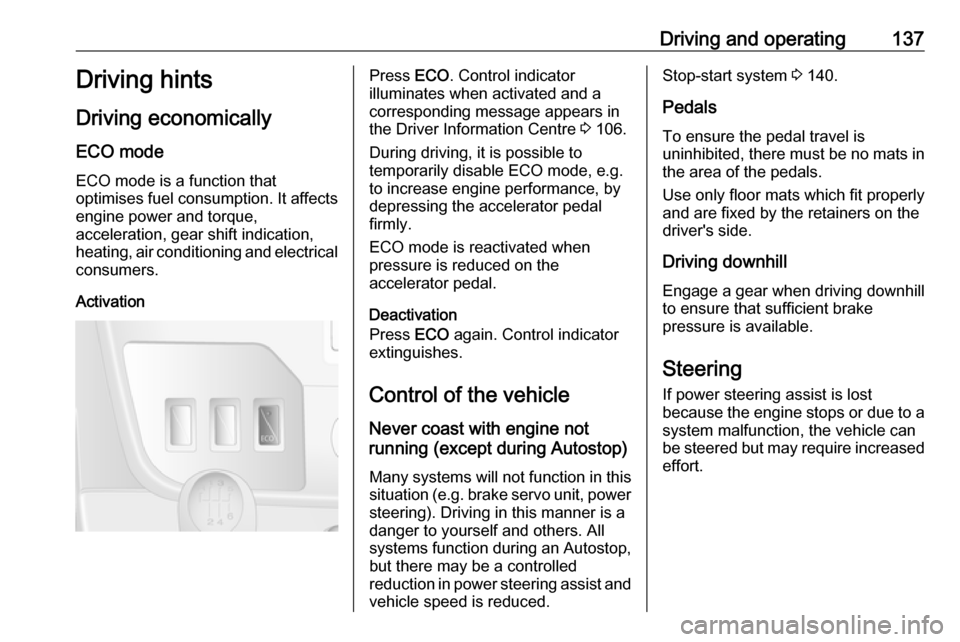
Driving and operating137Driving hints
Driving economically
ECO mode ECO mode is a function that
optimises fuel consumption. It affects
engine power and torque,
acceleration, gear shift indication,
heating, air conditioning and electrical consumers.
ActivationPress ECO. Control indicator
illuminates when activated and a corresponding message appears in
the Driver Information Centre 3 106.
During driving, it is possible to
temporarily disable ECO mode, e.g.
to increase engine performance, by
depressing the accelerator pedal
firmly.
ECO mode is reactivated when
pressure is reduced on the
accelerator pedal.
Deactivation
Press ECO again. Control indicator
extinguishes.
Control of the vehicle
Never coast with engine not
running (except during Autostop)
Many systems will not function in this
situation (e.g. brake servo unit, power
steering). Driving in this manner is a
danger to yourself and others. All
systems function during an Autostop,
but there may be a controlled
reduction in power steering assist and
vehicle speed is reduced.Stop-start system 3 140.
Pedals To ensure the pedal travel is
uninhibited, there must be no mats in
the area of the pedals.
Use only floor mats which fit properly and are fixed by the retainers on the
driver's side.
Driving downhill
Engage a gear when driving downhill
to ensure that sufficient brake
pressure is available.
Steering If power steering assist is lost
because the engine stops or due to a system malfunction, the vehicle can
be steered but may require increased
effort.
Page 141 of 271
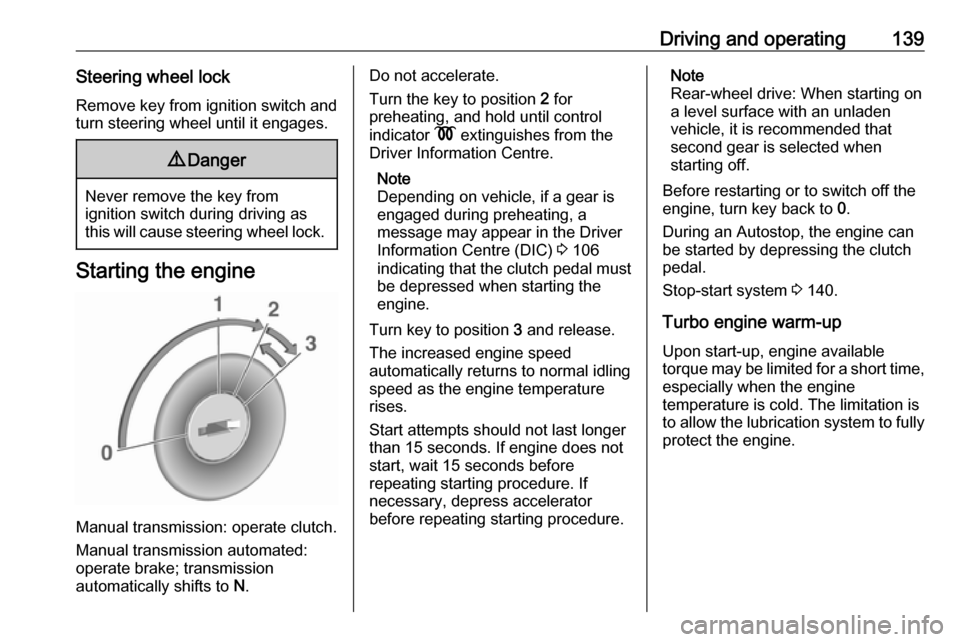
Driving and operating139Steering wheel lockRemove key from ignition switch and
turn steering wheel until it engages.9 Danger
Never remove the key from
ignition switch during driving as
this will cause steering wheel lock.
Starting the engine
Manual transmission: operate clutch.
Manual transmission automated:
operate brake; transmission
automatically shifts to N.
Do not accelerate.
Turn the key to position 2 for
preheating, and hold until control
indicator N extinguishes from the
Driver Information Centre.
Note
Depending on vehicle, if a gear is
engaged during preheating, a
message may appear in the Driver
Information Centre (DIC) 3 106
indicating that the clutch pedal must be depressed when starting the
engine.
Turn key to position 3 and release.
The increased engine speed
automatically returns to normal idling
speed as the engine temperature
rises.
Start attempts should not last longer
than 15 seconds. If engine does not
start, wait 15 seconds before
repeating starting procedure. If
necessary, depress accelerator
before repeating starting procedure.Note
Rear-wheel drive: When starting on
a level surface with an unladen
vehicle, it is recommended that
second gear is selected when
starting off.
Before restarting or to switch off the
engine, turn key back to 0.
During an Autostop, the engine can
be started by depressing the clutch
pedal.
Stop-start system 3 140.
Turbo engine warm-up
Upon start-up, engine available
torque may be limited for a short time, especially when the engine
temperature is cold. The limitation is
to allow the lubrication system to fully
protect the engine.
Page 165 of 271
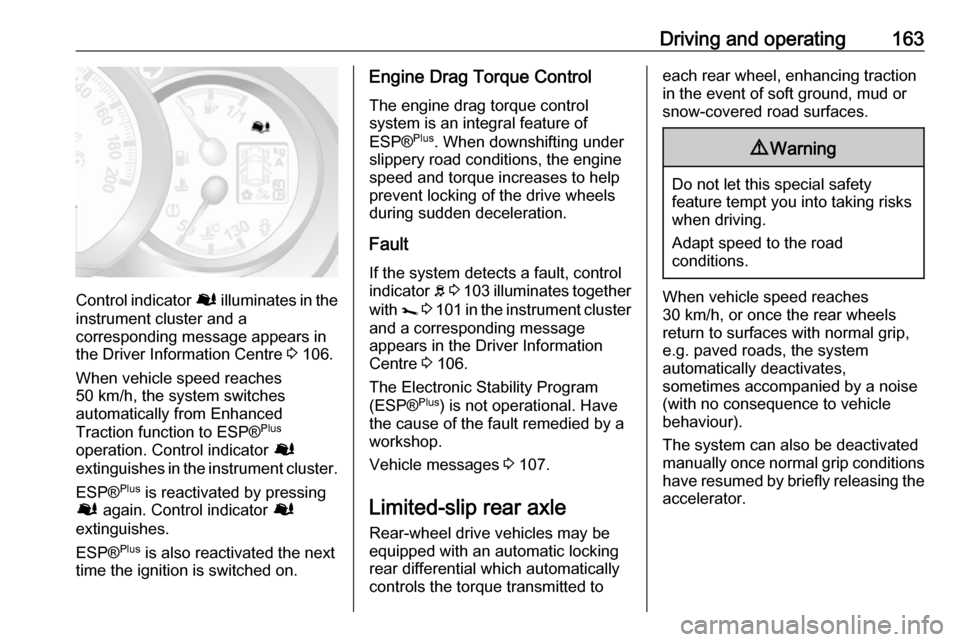
Driving and operating163
Control indicator Ø illuminates in the
instrument cluster and a
corresponding message appears in
the Driver Information Centre 3 106.
When vehicle speed reaches 50 km/h, the system switches
automatically from Enhanced
Traction function to ESP® Plus
operation. Control indicator Ø
extinguishes in the instrument cluster.
ESP® Plus
is reactivated by pressing
Ø again. Control indicator Ø
extinguishes.
ESP® Plus
is also reactivated the next
time the ignition is switched on.
Engine Drag Torque Control
The engine drag torque control
system is an integral feature of
ESP® Plus
. When downshifting under
slippery road conditions, the engine
speed and torque increases to help
prevent locking of the drive wheels
during sudden deceleration.
Fault
If the system detects a fault, control indicator b 3 103 illuminates together
with j 3 101 in the instrument cluster
and a corresponding message
appears in the Driver Information
Centre 3 106.
The Electronic Stability Program
(ESP® Plus
) is not operational. Have
the cause of the fault remedied by a
workshop.
Vehicle messages 3 107.
Limited-slip rear axle Rear-wheel drive vehicles may be
equipped with an automatic locking
rear differential which automatically
controls the torque transmitted toeach rear wheel, enhancing traction
in the event of soft ground, mud or
snow-covered road surfaces.9 Warning
Do not let this special safety
feature tempt you into taking risks
when driving.
Adapt speed to the road
conditions.
When vehicle speed reaches
30 km/h, or once the rear wheels
return to surfaces with normal grip,
e.g. paved roads, the system
automatically deactivates,
sometimes accompanied by a noise
(with no consequence to vehicle
behaviour).
The system can also be deactivated
manually once normal grip conditions have resumed by briefly releasing the
accelerator.
Page 217 of 271
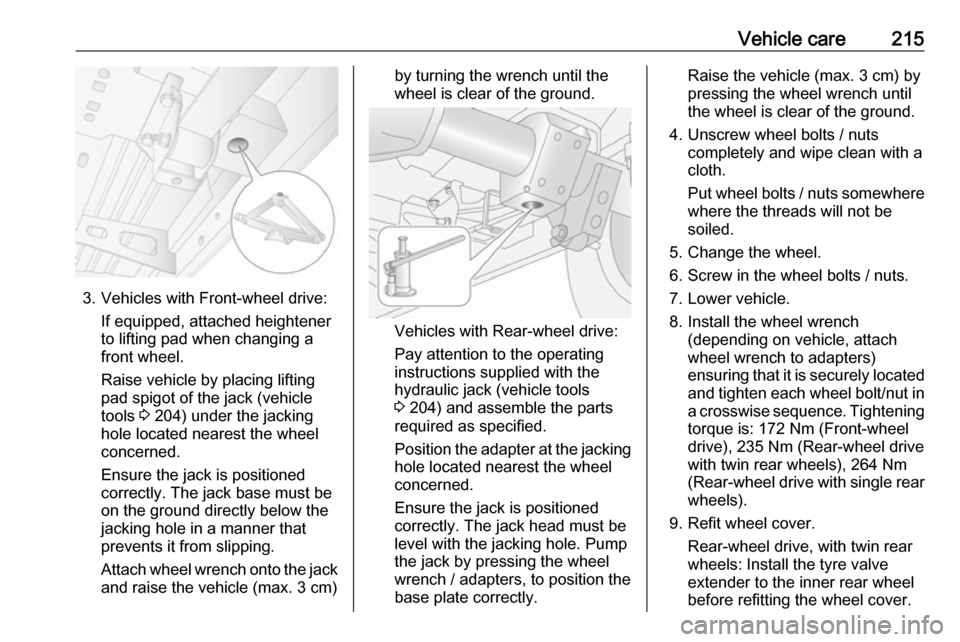
Vehicle care215
3. Vehicles with Front-wheel drive:If equipped, attached heightener
to lifting pad when changing a
front wheel.
Raise vehicle by placing lifting
pad spigot of the jack (vehicle
tools 3 204) under the jacking
hole located nearest the wheel
concerned.
Ensure the jack is positioned
correctly. The jack base must be
on the ground directly below the
jacking hole in a manner that
prevents it from slipping.
Attach wheel wrench onto the jack
and raise the vehicle (max. 3 cm)
by turning the wrench until the
wheel is clear of the ground.
Vehicles with Rear-wheel drive:
Pay attention to the operating
instructions supplied with the
hydraulic jack (vehicle tools
3 204) and assemble the parts
required as specified.
Position the adapter at the jacking
hole located nearest the wheel
concerned.
Ensure the jack is positioned
correctly. The jack head must be
level with the jacking hole. Pump
the jack by pressing the wheel
wrench / adapters, to position the base plate correctly.
Raise the vehicle (max. 3 cm) bypressing the wheel wrench until
the wheel is clear of the ground.
4. Unscrew wheel bolts / nuts completely and wipe clean with a
cloth.
Put wheel bolts / nuts somewhere
where the threads will not be
soiled.
5. Change the wheel.
6. Screw in the wheel bolts / nuts.
7. Lower vehicle.
8. Install the wheel wrench (depending on vehicle, attach
wheel wrench to adapters)
ensuring that it is securely located and tighten each wheel bolt/nut in
a crosswise sequence. Tightening torque is: 172 Nm (Front-wheel
drive), 235 Nm (Rear-wheel drive
with twin rear wheels), 264 Nm
(Rear-wheel drive with single rear wheels).
9. Refit wheel cover. Rear-wheel drive, with twin rear
wheels: Install the tyre valve
extender to the inner rear wheel
before refitting the wheel cover.
Page 218 of 271
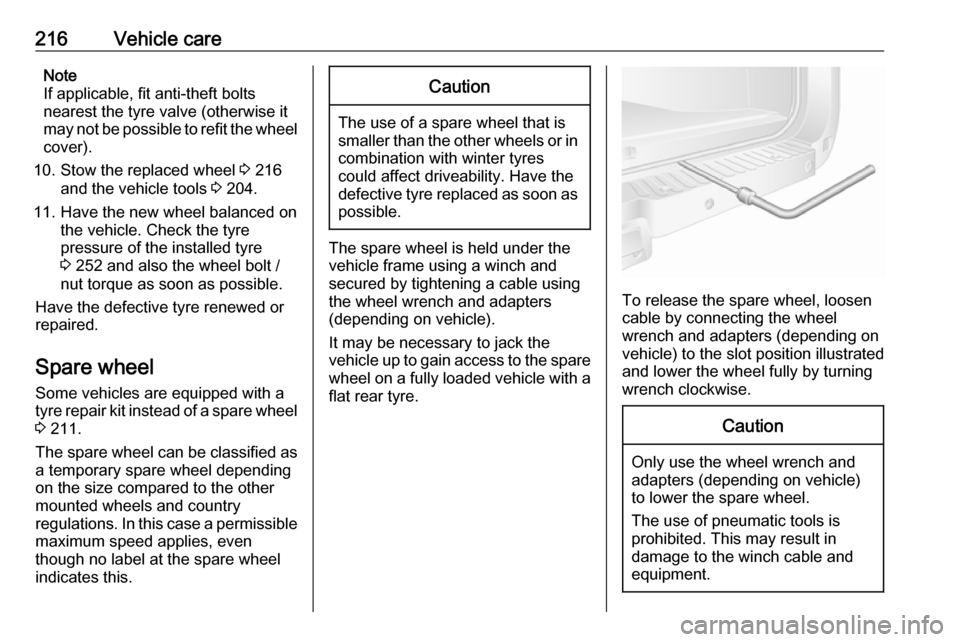
216Vehicle careNote
If applicable, fit anti-theft bolts
nearest the tyre valve (otherwise it
may not be possible to refit the wheel cover).
10. Stow the replaced wheel 3 216
and the vehicle tools 3 204.
11. Have the new wheel balanced on the vehicle. Check the tyre
pressure of the installed tyre
3 252 and also the wheel bolt /
nut torque as soon as possible.
Have the defective tyre renewed or
repaired.
Spare wheel Some vehicles are equipped with atyre repair kit instead of a spare wheel
3 211.
The spare wheel can be classified as
a temporary spare wheel depending
on the size compared to the other
mounted wheels and country
regulations. In this case a permissible maximum speed applies, even
though no label at the spare wheel
indicates this.Caution
The use of a spare wheel that is smaller than the other wheels or in combination with winter tyres
could affect driveability. Have the defective tyre replaced as soon as
possible.
The spare wheel is held under the
vehicle frame using a winch and
secured by tightening a cable using
the wheel wrench and adapters
(depending on vehicle).
It may be necessary to jack the
vehicle up to gain access to the spare
wheel on a fully loaded vehicle with a flat rear tyre.
To release the spare wheel, loosen
cable by connecting the wheel
wrench and adapters (depending on
vehicle) to the slot position illustrated
and lower the wheel fully by turning
wrench clockwise.
Caution
Only use the wheel wrench and
adapters (depending on vehicle)
to lower the spare wheel.
The use of pneumatic tools is
prohibited. This may result in
damage to the winch cable and
equipment.
Page 235 of 271

Technical data233Engine data
Sales designation
2.3 CDTI 1252.3 CDTI 110,
2.3 CDTI 110
ecoFLEX2.3 CDTI
BITURBO 1352.3 CDTI
1502.3 BITURBO
1632.3 BITURBO
163Engine identifier
codeM9TMH,
M9TMD,
M9TMJM9TMRM9TMNM9TMFM9TMPM9TMUNumber of
cylinders444444Piston
displacement [cm 3
]229822982298229822982298Engine power [kW]9281100110120120at rpm350035003500350035003500Torque [Nm]310285340/350 1)350360380at rpm1250-20001250-20001500-250015001500-27501500-2750Fuel typeDieselDieselDieselDieselDieselDiesel1)
Front-wheel drive / Rear-wheel drive.
Page 236 of 271

234Technical dataSales designation2.3 CDTI 1102.3 CDTI 1302.3 BITURBO 1302.3 BITURBO 1452.3 BITURBO 170Engine identifier codeM9TMWM9TMYM9TM1M9TMS, M9TMTM9TMLNumber of cylinders44444Piston displacement [cm3
]22982298229822982298Engine power [kW]819696107125at rpm35003500350035003500Torque [Nm]290320330360380at rpm1250150015001500-27501500-2750Fuel typeDieselDieselDieselDieselDiesel
Page 265 of 271

263Charging system ........................ 101
Child locks ................................... 31
Child restraint installation locations ................................... 70
Child restraints.............................. 67
Child restraint systems ................67
Cigarette lighter ........................... 93
Cleaning the vehicle ...................223
Climate control ............................. 17
Climate control systems .............120
Clock ............................................ 91
Coat hooks ................................... 77
Control indicators.......................... 97
Control of the vehicle .................137
Controls ........................................ 88
Convex shape .............................. 40
Coolant ....................................... 185
Coolant and antifreeze ...............228
Coolant heater ............................ 127
Cornering light ....................115, 191
Cornering lights .......................... 115
Coupling ball bar ........................178
Cruise control ....................105, 164
Cupholders .................................. 77
D
Danger, Warnings and Cautions ...4
Dashboard .................................... 11
Daytime running lights ...............115
Declaration of conformity ............254DEF............................................ 147
Demisting and defrosting ..............17
Diesel exhaust fluid ....................147
Diesel fuel ................................... 175
Diesel fuel filter .......................... 189
Diesel fuel system bleeding .......189
Diesel particle filter ....................146
Door locks..................................... 25
Door open .................................. 106
Doors ............................................ 32
DPF (diesel particle filter) ...........146
Drain fuel filter ........................... 105
Drink holders ................................ 77
Driver assistance systems ..........164
Driver Information Centre ...........106
Driving characteristics and towing tips .............................. 177
Driving economically................... 137
Driving hints ................................ 137
E
ECO mode .................................. 137
ecoScoring.................................. 109
Electric adjustment ......................41
Electrical accessories ...................91
Electrical system......................... 200
Electronic climate control system 122
Electronic driving programmes ..157
Electronic key system ...................24Electronic Stability Program .....
................................ 103, 162, 178
Electronic Stability Program off . 103
Emergency exit .......................44, 46
End-of-life vehicle recovery .......182
Engine compartment fuse box ...201
Engine coolant ........................... 185
Engine coolant temperature ......103
Engine coolant temperature gauge ....................................... 95
Engine data ............................... 233
Engine Drag Torque Control ......162
Engine exhaust .......................... 146
Engine identification ...................231
Engine oil ................... 183, 228, 232
Engine oil additives ....................228
Engine oil level monitor ................96
Engine oil pressure ....................104
Engine oil viscosity grades .........228
Enhanced Traction function....... ................................ 161, 162, 163
Event data recorders ..................258
Exhaust gases ............................ 146
Exit lighting ................................ 119
Exterior care .............................. 223
Exterior light ............................... 105
Exterior lighting ....................15, 112
Exterior mirrors ............................. 40